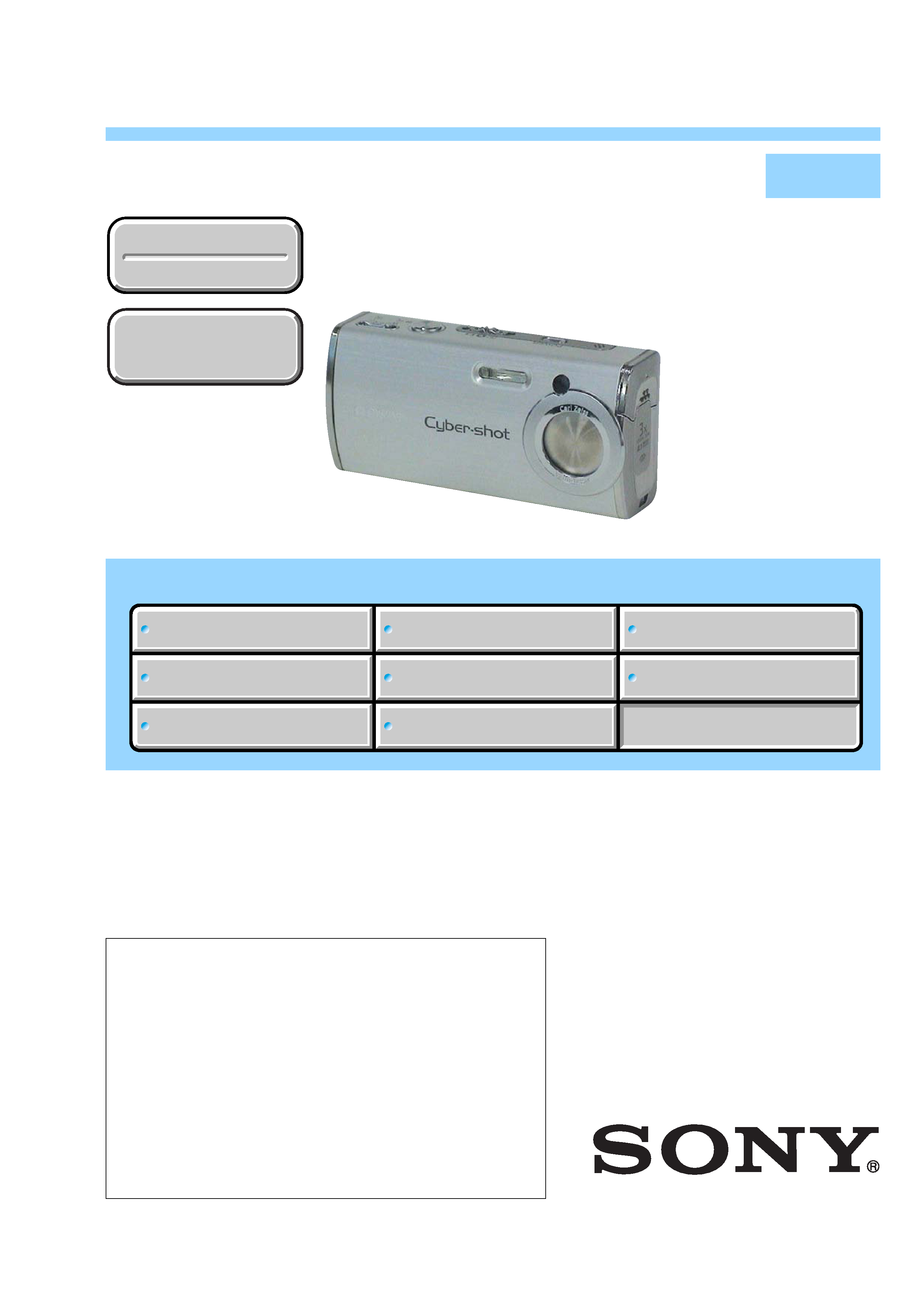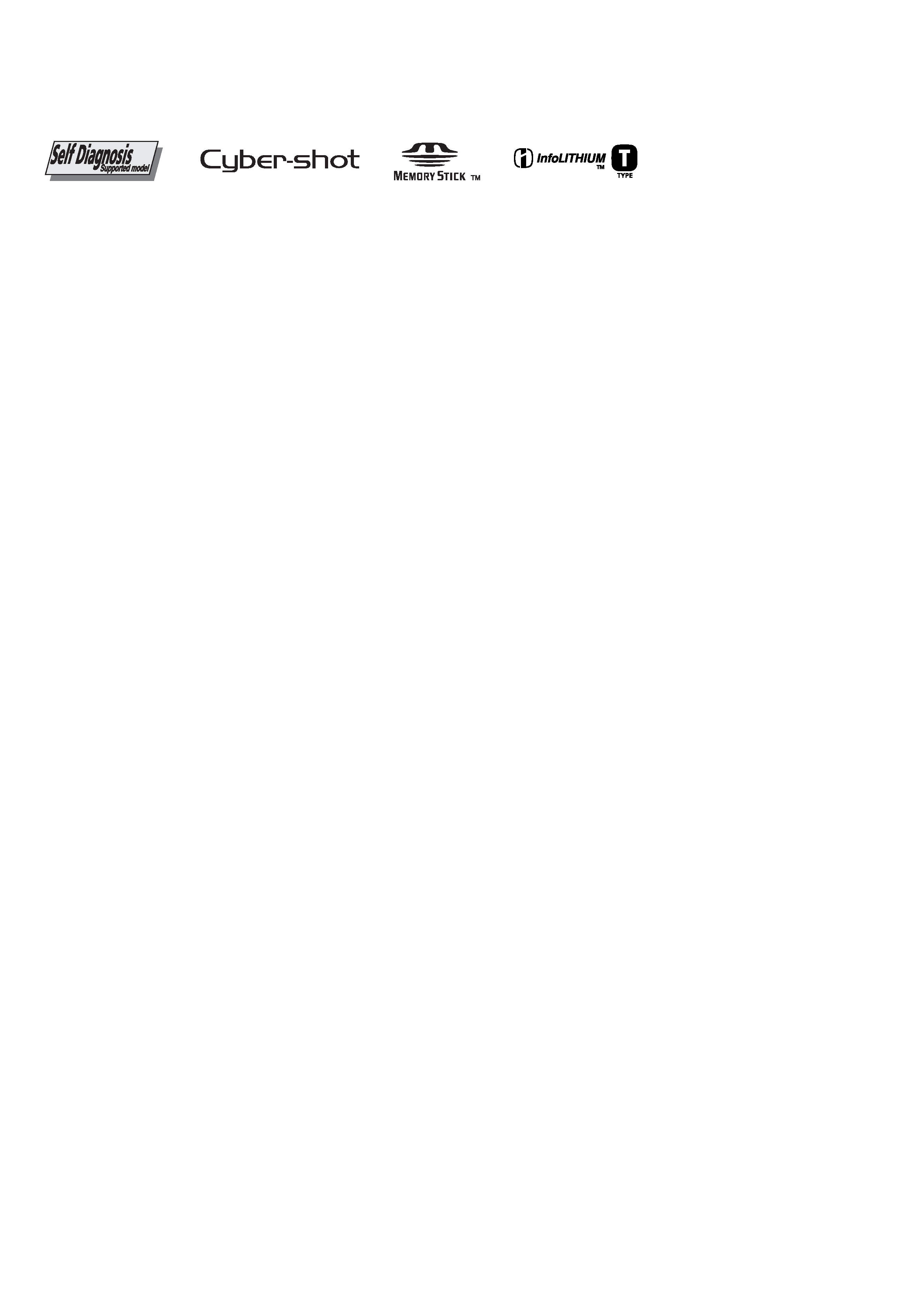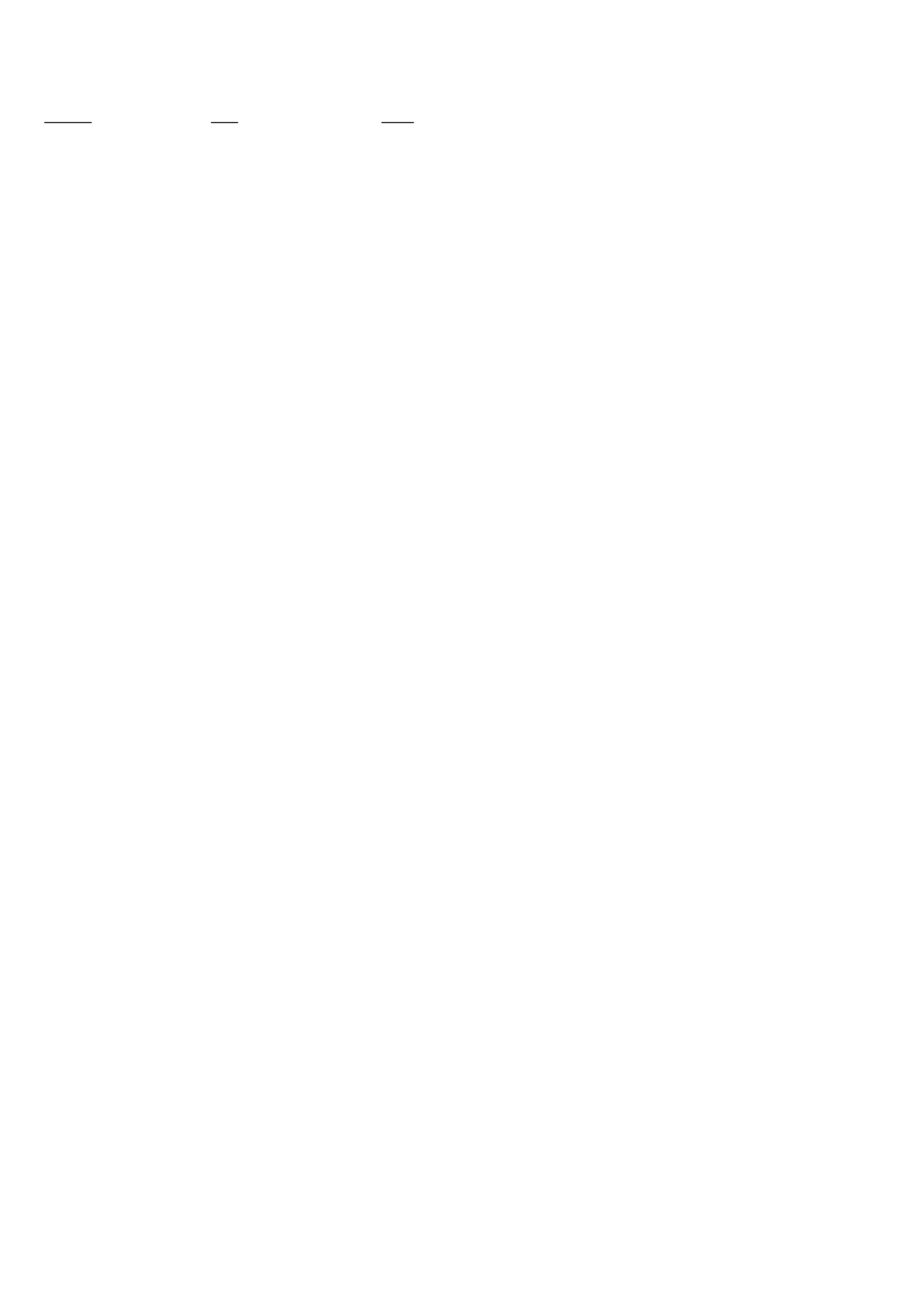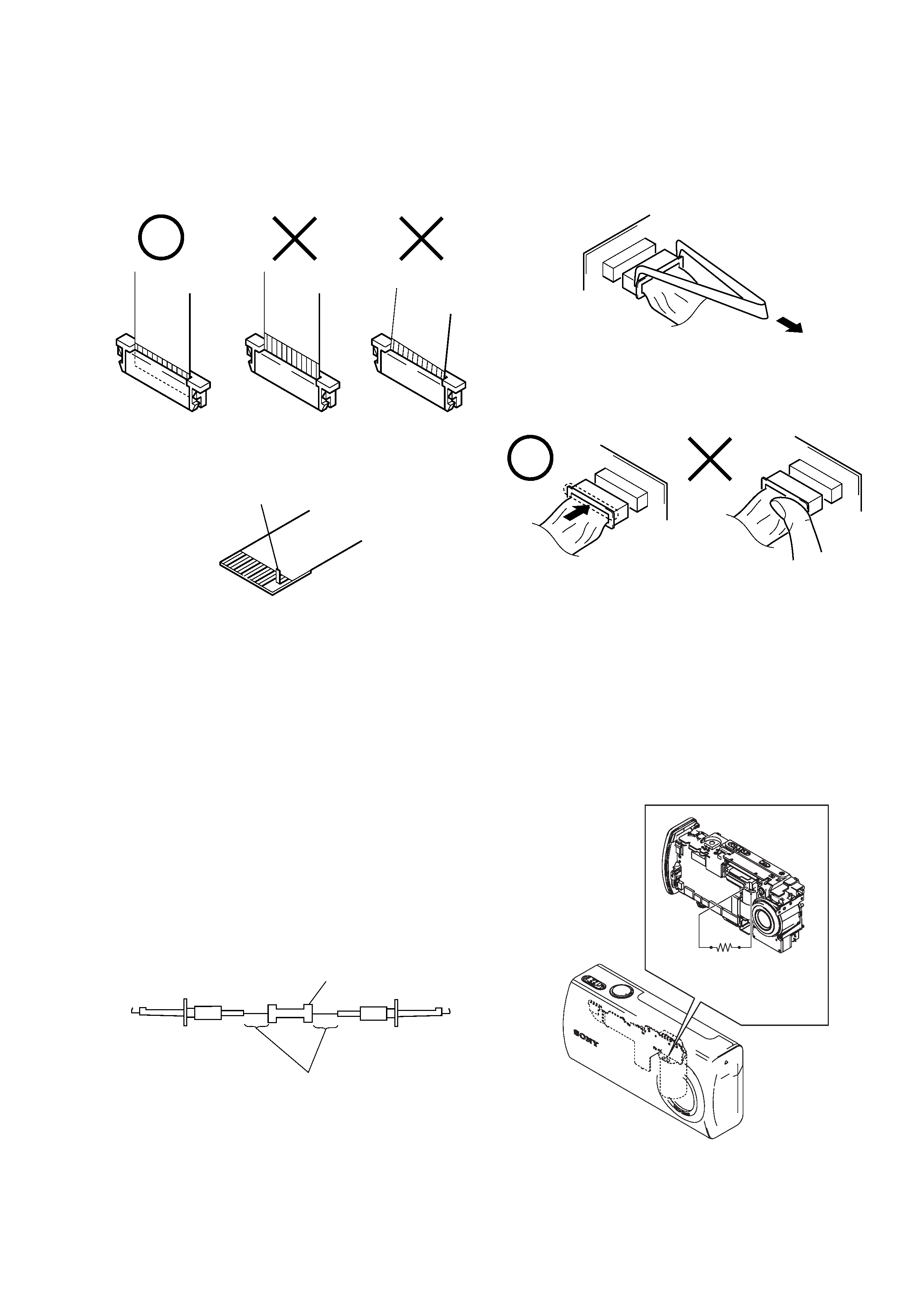
SERVICE MANUAL
LEVEL
2
Link
SERVICE NOTE
DISASSEMBLY
BLOCK DIAGRAMS
FRAME SCHEMATIC DIAGRAM
SCHEMATIC DIAGRAMS
PRINTED WIRING BOARDS
REPAIR PARTS LIST
SPECIFICATIONS
SERVICE NOTE
DISASSEMBLY
BLOCK DIAGRAMS
FRAME SCHEMATIC DIAGRAM
SCHEMATIC DIAGRAMS
PRINTED WIRING BOARDS
REPAIR PARTS LIST
SPECIFICATIONS
Link
Revision History
Revision History
How to use
Acrobat Reader
How to use
Acrobat Reader
Sony EMCS Co.
DSC-L1
·For ADJUSTMENTS (SECTION 6), refer to SERVICE MANUAL, ADJ (9-876-760-51).
·For INSTRUCTION MANUAL, refer to SERVICE MANUAL, LEVEL 1 (9-876-760-41).
· Reference No. search on printed wiring boards is available.
· The Cautions at the Time of Lens Block Handling
· The Method of Attachment of LC-084 Flexible Board
· The Method of Attachment of USB and DC IN Jacks on the JK-276 Flexible Board
· HELP: Sheet attachment positions and procedures of processing the flexible boards/harnesses are shown.
Ver 1.3 2005.07
DIGITAL STILL CAMERA
On the CH-147 and SY-110 boards
This service manual procides the information that is premised the
circuit board replacement service and not intended repair inside the
CH-147 and SY-110 boards.
Therefore, schematic diagram, printed wiring board and electrical
parts list of the CH-147 and SY-110 boards are not shown.
The following pages are not shown.
Schematic diagram ................... Pages 4-9 to 4-28
Printed wiring board .................. Pages 4-37 to 4-40
Waveforms ................................ Pages 4-49 and 4-50
Mounted parts location .............. Page 4-51
Electrical parts list ..................... Pages 5-7 and 5-10 to 5-13
The above-described information is shown in service manual Level 3.
DSC-L1
2005G0500-1
© 2005.7
Published by DI Technical Support Department
9-876-760-31
US Model
Canadian Model
AEP Model
UK Model
E Model
Hong Kong Model
Australian Model
Chinese Model
Korea Model
Brazilian Model
Tourist Model
Japanese Model
Photo: Silver

-- 2 --
DSC-L1
SPECIFICATIONS
See page 5-14.

-- 3 --
DSC-L1
SAFETY-RELATED COMPONENT WARNING!!
COMPONENTS IDENTIFIED BY MARK 0 OR DOTTED LINE WITH
MARK 0 ON THE SCHEMATIC DIAGRAMS AND IN THE PARTS
LIST ARE CRITICAL TO SAFE OPERATION. REPLACE THESE
COMPONENTS WITH SONY PARTS WHOSE PART NUMBERS
APPEAR AS SHOWN IN THIS MANUAL OR IN SUPPLEMENTS
PUBLISHED BY SONY.
ATTENTION AU COMPOSANT AYANT RAPPORT
À LA SÉCURITÉ!
LES COMPOSANTS IDENTIFÉS PAR UNE MARQUE 0 SUR LES
DIAGRAMMES SCHÉMATIQUES ET LA LISTE DES PIÈCES SONT
CRITIQUES POUR LA SÉCURITÉ DE FONCTIONNEMENT. NE
REMPLACER CES COMPOSANTS QUE PAR DES PIÈSES SONY
DONT LES NUMÉROS SONT DONNÉS DANS CE MANUEL OU
DANS LES SUPPÉMENTS PUBLIÉS PAR SONY.
1.
Check the area of your repair for unsoldered or poorly-soldered
connections. Check the entire board surface for solder splashes
and bridges.
2.
Check the interboard wiring to ensure that no wires are
"pinched" or contact high-wattage resistors.
3.
Look for unauthorized replacement parts, particularly
transistors, that were installed during a previous repair. Point
them out to the customer and recommend their replacement.
4.
Look for parts which, through functioning, show obvious signs
of deterioration. Point them out to the customer and
recommend their replacement.
5.
Check the B+ voltage to see it is at the values specified.
6.
Flexible Circuit Board Repairing
·Keep the temperature of the soldering iron around 270°C
during repairing.
· Do not touch the soldering iron on the same conductor of the
circuit board (within 3 times).
· Be careful not to apply force on the conductor when soldering
or unsoldering.
Unleaded solder
Boards requiring use of unleaded solder are printed with the lead-
free mark (LF) indicating the solder contains no lead.
(Caution: Some printed circuit boards may not come printed with
the lead free mark due to their particular size.)
: LEAD FREE MARK
Unleaded solder has the following characteristics.
· Unleaded solder melts at a temperature about 40
°C higher than
ordinary solder.
Ordinary soldering irons can be used but the iron tip has to be
applied to the solder joint for a slightly longer time.
Soldering irons using a temperature regulator should be set to
about 350
°C.
Caution: The printed pattern (copper foil) may peel away if the
heated tip is applied for too long, so be careful!
· Strong viscosity
Unleaded solder is more viscous (sticky, less prone to flow) than
ordinary solder so use caution not to let solder bridges occur such
as on IC pins, etc.
· Usable with ordinary solder
It is best to use only unleaded solder but unleaded solder may
also be added to ordinary solder.
SAFETY CHECK-OUT
After correcting the original service problem, perform the following
safety checks before releasing the set to the customer.
CAUTION
Danger of explosion if battery is incorrectly replaced.
Replace only with the same or equivalent type.

-- 4 --
DSC-L1
TABLE OF CONTENTS
1.
SERVICE NOTE
1-1.
Note for Repair ································································ 1-1
1-2.
Discharging of the ST-109 Flexible Board's Charging
Capacitor (C050) ····························································· 1-1
1-3.
The Cautions at the Time of Lens Block Handling ········· 1-2
1-4.
Description on Self-diagnosis Display ···························· 1-2
2.
DISASSEMBLY
2-1.
Disassembly ····································································· 2-1
2-2.
Service Position ······························································· 2-5
2-3.
The Method of Attachment of LC-084 Flexible Board ··· 2-7
2-4.
The Method of Attachment of USB and DC IN Jacks
on the JK-276 Flexible Board ········································· 2-9
2-5.
Circuit Boards Location ················································ 2-10
3.
BLOCK DIAGRAMS
3-1.
Overall Block Diagram (1/2) ··········································· 3-1
3-2.
Overall Block Diagram (2/2) ··········································· 3-3
3-3.
Power Block Diagram (1/2) ············································· 3-5
3-4.
Power Block Diagram (2/2) ············································· 3-7
4.
PRINTED WIRING BOARDS AND
SCHEMATIC DIAGRAMS
4-1.
Frame Schematic Diagram ·············································· 4-1
4-2.
Schematic Diagrams ························································ 4-5
CD-526 FLEXIBLE (CCD IMAGER) ··························· 4-7
JK-276 FLEXIBLE (JACK, CONTROL SWITCH) ···· 4-29
ST-109 FLEXIBLE (FLASH DRIVE) ························· 4-31
SW-432 FLEXIBLE (CONTROL SWITCH) ··············· 4-33
MS-238 FLEXIBLE
(MEMORY STICK CONNECTOR) ···························· 4-34
LC-084 FLEXIBLE (LENS COVER MOTOR) ··········· 4-34
4-3.
Printed Wiring Boards ··················································· 4-35
JK-276 FLEXIBLE ······················································· 4-41
ST-109 FLEXIBLE ······················································· 4-43
SW-432 FLEXIBLE ······················································ 4-45
MS-238 FLEXIBLE ······················································ 4-47
LC-084 FLEXIBLE ······················································· 4-47
4-5.
Mounted Parts Location ················································ 4-52
5.
REPAIR PARTS LIST
5-1.
Exploded Views ······························································· 5-2
5-1-1. Cabinet (Front) Block ······················································ 5-2
5-1-2. Cabinet (Upper) Block ···················································· 5-3
5-1-3. Battery Holder Block ······················································· 5-4
5-1-4. Cabinet (Rear) Block ······················································· 5-5
5-2.
Electrical Parts List ························································· 5-6
Section
Title
Page

1-1
DSC-L1
1-2. DISCHARGING OF THE ST-109
FLEXIBLE BOARD'S CHARGING
CAPACITOR (C050)
The charging capacitor (C050) of the ST-109 flexible board is
charged up to the maximum 300 V potential.
There is a danger of electric shock by this high voltage when the
capacitor is handled by hand. The electric shock is caused by the
charged voltage which is kept without discharging when the main
power of the unit is simply turned off. Therefore, the remaining
voltage must be discharged as described below.
Preparing the Short Jig
To preparing the short jig, a small clip is attached to each end of a
resistor of 1 k
/1 W (1-215-869-11).
Wrap insulating tape fully around the leads of the resistor to prevent
electrical shock.
1 k
/1 W
Wrap insulating tape.
Discharging the Capacitor
Short-circuit between the positive and the negative terminals of
charged capacitor with the short jig about 10 seconds.
1-1. NOTE FOR REPAIR
Make sure that the flat cable and flexible board are not cracked of
bent at the terminal.
Do not insert the cable insufficiently nor crookedly.
Cut and remove the part of gilt
which comes off at the point.
(Be careful or some
pieces of gilt may be left inside)
When remove a connector, don't pull at wire of connector.
It is possible that a wire is snapped.
When installing a connector, don't press down at wire of connector.
It is possible that a wire is snapped.
1. SERVICE NOTE
R:1 k
/1 W
(Part code:
1-215-869-11)
